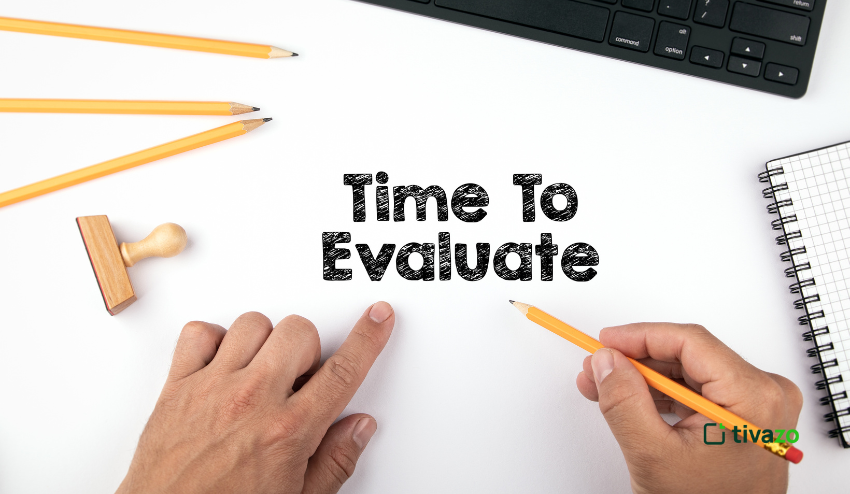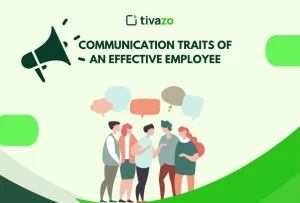Employee Evaluation lies at the core of any successful organization. It’s used by companies to measure performance, ascertain high-potential talent, or address inefficiencies. But the traditional modes of employee evaluation are time-consuming, bias-prone, and offer little to real-time insights.
That’s where Tivazo, a clever time tracking and productivity aiding tool, comes in. By way of time tracking during evaluating an employee, one could observe decisions from a data perspective, thus ensuring that these are fair, transparent, and in fact, actionable.
In this article, we discuss employee evaluation, its importance, conducting appropriate evaluations, and how time-tracking tools like Tivazo can change the scenario. The guide will walk you through everything you need to be aware of to enable better evaluation of your teams, be you are a manager, an HR leader, or even a business owner.
Key Highlights:
- What is Employee Evaluation?
- Why Do Traditional Employee Evaluations Fail?
- How to Evaluate and Track Employee Performance
- Is Employee Time Tracking Valuable?
- How does tracking time help evaluate employees?
- Best Practices for Using Time Tracking in Staff Reviews
What is Employee Evaluation?
Employee evaluation is the formal process of evaluating an employee’s performance over time. Often, evaluations will measure certain behaviors, including productivity, skill level, quality of work, time and attendance, teamwork, and the ability to meet deadlines or organizational needs. Having a documented employee evaluation process helps the organization to understand how every team member is contributing to the organizational mission and aims at identifying areas to support, coach, and celebrate.
Employee evaluations can take many forms – annual performance evaluations, quarterly evaluations, check-ins, progress meetings, or may provide regular, ongoing feedback through various workflows and data tools like Tivazo.
In an ever-changing, fast-paced, high-impact business world, old ways of evaluating employees (an opinion, occasional review, and evaluations) are not enough anymore. Data combined, especially time tracking, makes evaluation necessary. Evidence of data is stronger than subjectivity. Employees want dignity. Organizations can gather subjective but actionable feedback, and using tools defined as learning performance tools can also benchmark productivity with facts and keep the discussion of employee evaluations fair, transparent, and actionable.
Common purposes for employee evaluation are identified objectively:
| Objective | Purpose |
| Performance Measurement | Determine to what extent an employee is performing. |
| Goal Alignment | Access if there is alignment between employee objectives and performance outcomes. |
| Skill Gap Identification | Identify areas to train employees, areas for job development |
| Compensation and Promotion | Supporting evidence of why an employee received a raise, and also use evidence on why an employee |
| Motivation and Engagement | Encourage students to believe in their self-improvement, as we have to reengage them regularly and consistently. |
Why Do Traditional Employee Evaluations Fail?
Annual reviews and manager-based feedback have been the norms for many years and consequently tend to suffer from a lack of objectivity. The problem is that many businesses resort to opinions instead of using data, causing:
- Bias and favoritism
- Obsolete feedback
- No clear performance benchmark
- No real quantifiable improvement
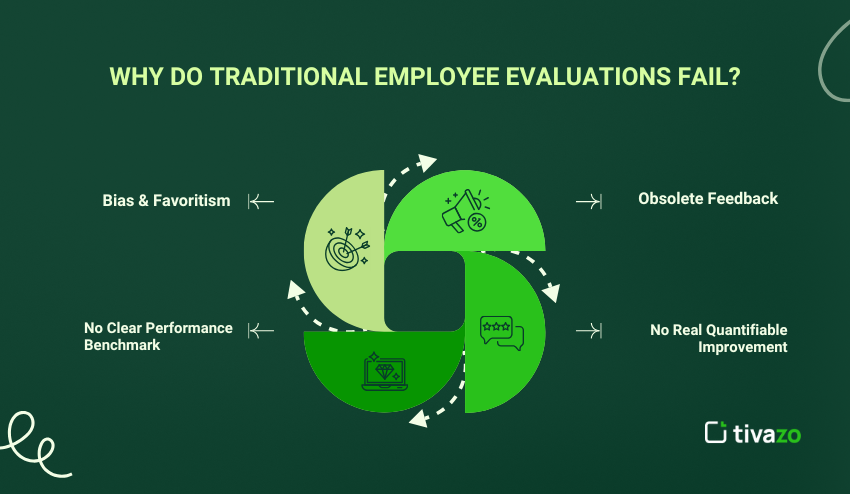
The traditional employee evaluations are usually done based on memory or impression, rather than real-time insights. This could create a disconnect in how employees perceive their contributions and how they are evaluated. For example, an employee who is performing well every day may get average feedback simply because the excellent job was done months earlier and no one remembered it much at the time of review.
In addition, since there are no clear metrics, evaluations may not be the same across teams or departments. What one manager regards as “high performance” may be substantially different from what another manager regards as such. This inconsistency can affect morale and be detrimental when it comes to promotions, salary decisions, and employee retention.
Another issue is the reactive nature of traditional evaluation: They tend to review what went wrong in the past and never on what could be the future steps for fixes or growth. Hence, employees are devoid of quick direction regarding their development.
Time tracking, therefore, becomes essential. Tivazo provides managers with real-time insights into performance, driving evaluations that are fair and consistent future! This negates all guesswork and integrates evaluations into actionable data-driven modeling for continuous improvement.
How to Evaluate and Track Employee Performance
Modern employee evaluation combines multiple data points, several feedback channels, and real-time tracking. The structure of a well-balanced review process selected with consistency and objectivity will be oriented to achieving company goals while working toward employee development. Here are some possibilities to make your evaluation process more effective for the future:
1. Setting KPIs and Goals
Before evaluation, establish what “successful” really means. Clear Key Performance Indicators give both employees and managers a benchmark against which to track progress.
Examples of KPIs for evaluation:
- Time spent on core tasks
- Project completion rate
- The response rate to clients or internal queries
- Number of errors, changes, or bugs
- Meeting deadlines and standards of good quality
- Customer satisfaction ratings (for client-facing roles)
Individual goals must be set according to team and company goals.
When employees know what is expected, they are more motivated and hold themselves accountable
2. Use Time Tracking Tools such as Tivazo
From which timekeeping software has developed from merely turning the clock in or out, Tivazo provides dashboards packed with insights into employee evaluation and performance-just from hours worked to task division. Competency evaluation is clearer with precise, real-time data.
Key Benefits of Using Tivazo for Employee Evaluation:
- Transparent work logs – Know what’s done, when, and for how long
- Productivity heatmaps – Identify peak productivity periods
- Task-level time allocation – See how time is spent across different assignments
- Idle vs. active hours – Monitor focus and efficiency
- Remote team monitoring – Track distributed teams without micromanaging
What Tivazo offers is a deep dive into tracking behavioral patterns, bottlenecks, and output-affecting indices rather than just time-tracking!
3. Gather Multi-Source Feedback
Don’t settle on one viewpoint, and while it is most common in the past to obtain feedback from a manager, I would introduce 360-degree feedback from teammates, direct reports (subordinates), and managers. This type of rounded view that also takes into account Tivazo’s time log feedback provides an all-encompassing view of an employee’s performance.
Peer feedback can provide additional depth; for example, you learn about teamwork, communication, collaboration, etc., that time logs simply cannot know.
4. Analyze Quantitative and Qualitative Data
Quantitative data, like hours worked or tasks completed, only tells half the story. You need both the qualitative considerations of feedback, such as project challenges, difficulty, innovative thinking, or whether they showed leadership, etc., to evaluate an employee objectively.
Tivazo also makes it easy to export, consume, or integrate that data into HR systems or performance management platforms, giving you a framework to relate that raw HR or operational data to meaningful insights at the organization, department, or employee evaluation level. You will then be able to track trends over time and chart improvement or regression.
5. Have More Frequent Check-Ins
Instead of only an annual review, you can have monthly or quarterly checks using Tivazo data to help organize and document your feedback. These frequent check-ins can also help avoid problems in the first instance, or at the very least address them before they lead to bigger issues, align staff with a department and an organization, and promote open communication.
Workforce professionals or employees will prefer, and tell you, they want more frequent feedback. It decreases their anxiety, builds trust, engages them, and allows a more human interaction between bosses and employees. And also, let managers acknowledge good work when it happens, not months later.
6. Tailor Evaluation Frameworks by Role
Every type of role cannot be evaluated using the same set of criteria. Using Tivazo, the time tracking and productivity insights can be tailored for the nature of the job, be it creative, technical, administrative, or strategic.
For example:
- A content writer may be evaluated on hours spent writing vs. time researching.
- A developer may be tracked on active coding hours vs. debugging sessions.
- A customer support agent can be evaluated by response times and ticket resolutions.
- Customized tracking makes the employee evaluation process more relevant and fair.
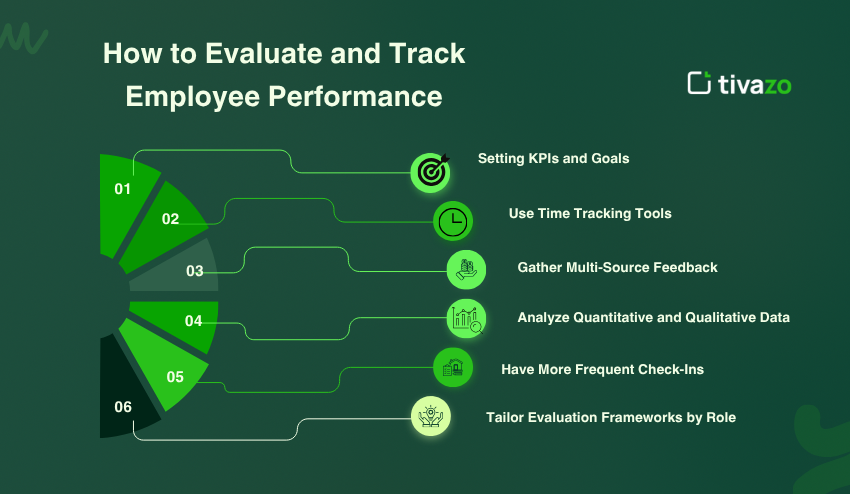
Is Employee Time Tracking Valuable?
Definitely! Time tracking is a highly underrated source for performance measurement. It’s about much more than just payroll or project management, it gives a very accessible way to make objectively assessable employee evaluations.
How Time Tracking Contributes to Effective Evaluations
| Feature | Meaning of Employee Evaluation |
| Real-Time Visibility | Have an accurate appraisal of daily performance |
| Task Time Allocation | Identify how time is allocated to the project/task completed |
| Focus Tracking | Assess any distractions to encourage focus |
| Accountability | Employees take personal responsibility for managing their productivity |
| Historical Data Records | Benchmark performance over weeks or months |
Tivazo combines all of these features into essentially one product. The platform, with its integrations, customizable reports, and a platform accessible for remote teams, makes time tracking the foundation of performance evaluation.
How does tracking time help evaluate employees?
Let’s get more specific when tracking time, how does it help evaluate employees, using real examples?
1. Performance data
Annual performance evaluations include a lot of subjectivity. When you implement Tivazo, you receive data that is factual — no guessing.
Example: An employee evaluation reports being overloaded. You find from Tivazo that they are spending 3 hours per day on unrelated optional tasks. There is an opportunity to optimize the processes and practices.
2. Identify high performers
Using productivity data with similar jobs, you can compare across employees and recognize top performers and find ways to duplicate their mode of operation across the team.
Example: Two designers are similar projects. One designer completes many more tasks in less time and maintains quality. Tivazo data can support this conclusion, so you can promote or bonus to the right employee.
3. Bring up low productivity
Tivazo gives you the ability to identify slow performance before it becomes an issue. There is no need to wait for your annual review process to act.
Example: You notice a team member has consistency in hours tracked, but minimal tasks. When you check their screen logs, you note they are spending a lot of time on tools (including rampant Google searches) that are unrelated to the tasks they are working on.
4. Better oversight of remote employees
Without data to evaluate, it is hard to manage remote employees. With Tivazo, tracking hours, activity levels, and time on projects gets you the data to do so for your remote team.
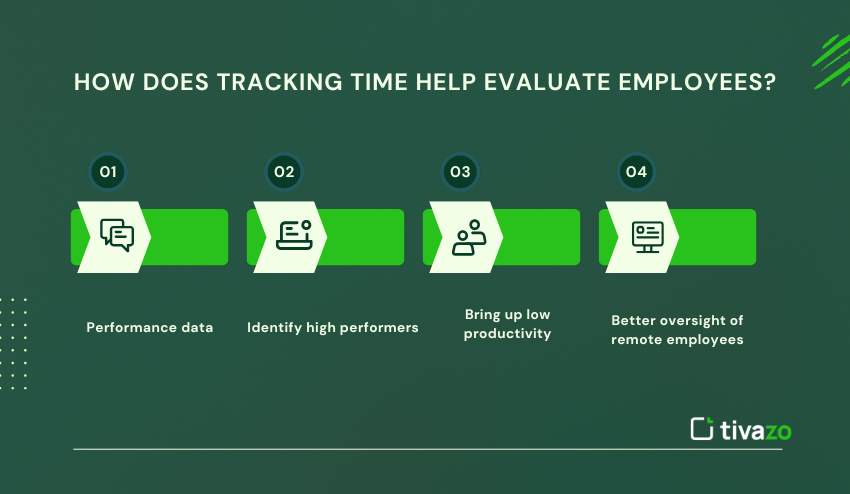
Best Practices for Using Time Tracking in Staff Reviews
Follow these best practices for making the most out of your time tracking solution for employee evaluation:
1. Be Transparent
Be open with your team about how and why you are tracking time; following up on the experience of using time tracking, not as a way to micromanage, but as a new way to help them grow and be successful.
2. Track Useful Metrics
Consider what data is helpful and relevant to gather from the time tracking system; total hours worked, amounts of activity, types of activity, idle time, and output were the best metrics for your use case. Track whatever is useful for you, but don’t track every little thing to the point where it becomes intrusive.
3. Be Data-Informed, Not Data-Dictated
Approach time tracking as a guide, rather than the absolute way to evaluate someone. People are still humans and deserve to be treated as such. Doing something as harmless as installing time tracking software doesn’t allow you to abandon the need for empathy when thinking about employee well-being or treating someone with value beyond their time.
4. Leverage Integrations
Tivazo integrates nicely with Slack, Trello, Asana, and Jira. Take advantage of how those integrations will allow you to provide consistent data points when making evaluations.
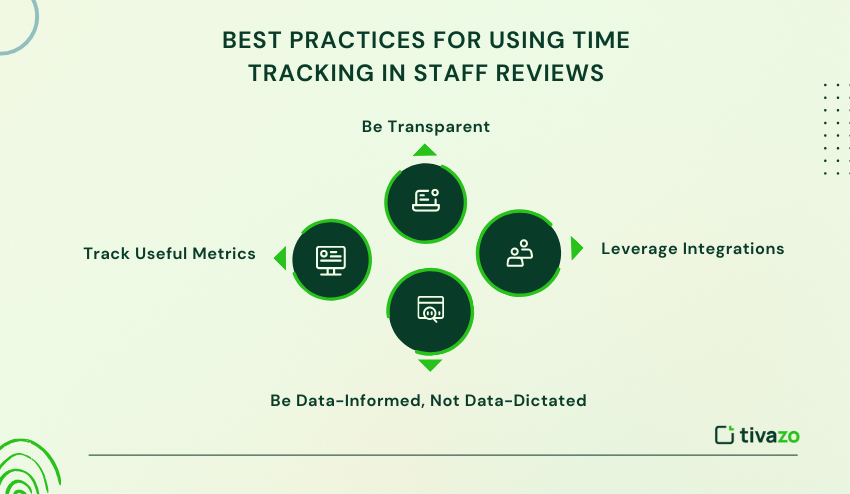
What are the limitations of other tools, for instance?
- Tracking to your needs: Generally caused by feature overload, your team can select what to track.
- Real tracking data: Allows organizations to realize performance trends from time data.
- Remote-ready: Remote first & Hybrid teamwork is possible; geographically distributed teams are great.
- Security is a priority: Your data is both encrypted and employee-oriented.
- Scalable: From 10 to 1000 personnel, Tivazo can manage the workflows.
Conclusion
Gone are the days of once-a-year, paper-based employee evaluations. It now becomes a thriving, ongoing assessment process, with time tracking being the right approach.
Using a tool such as Tivazo, you can track productivity, spot areas of improvement, work on them with your workforce, and help achieve its full potential. Tracking time provides transparency and fairness that traditional reviews do not, for example, during performance-based promotions and training applications, as well as productivity increases.
How to evaluate and track employee performance?
Set clear goals and objectives for each employee. ...
Select key performance indicators (KPIs) to measure success. ...
Take performance measurements across the year (not just at the moment of review) ...
Provide constant feedback on performance. ...
Be moderate with criticism.
Is time tracking employees effective?
Ensures that employees get paid appropriately for every minute they work, thus fusing with trust and satisfaction. A robust system of time tracking aids in the management of project timelines, thereby enabling improved planning and execution.
Is time tracking employees effective?
Correct payment for hours worked ensures trust and satisfaction with employees. A perfect time-tracking tool helps govern project schedules, thereby helping with better planning and execution.
